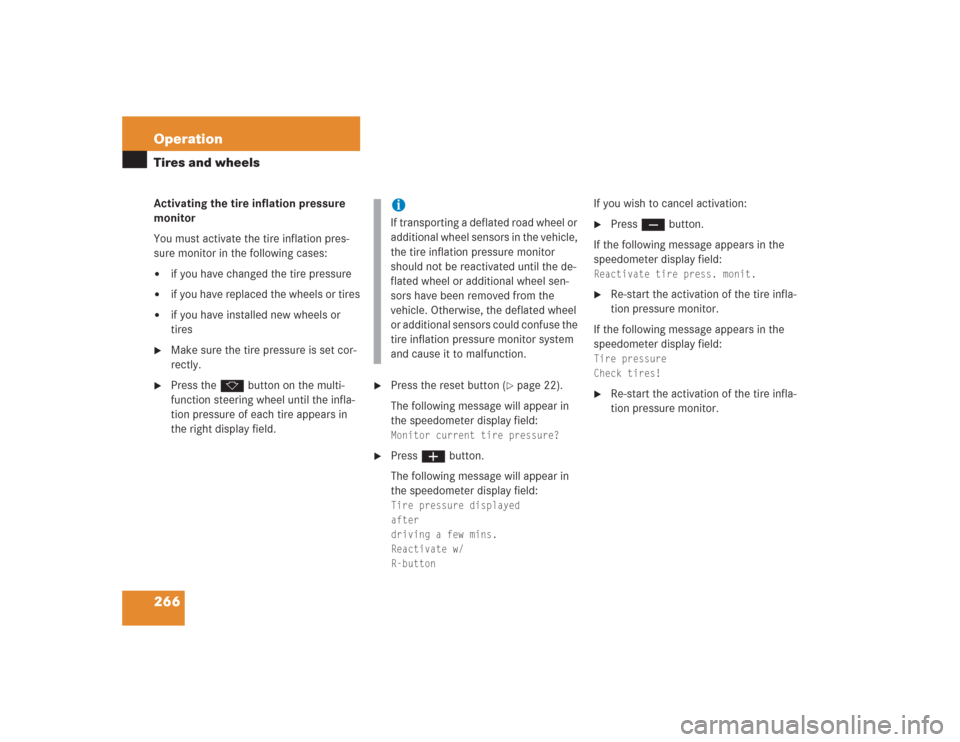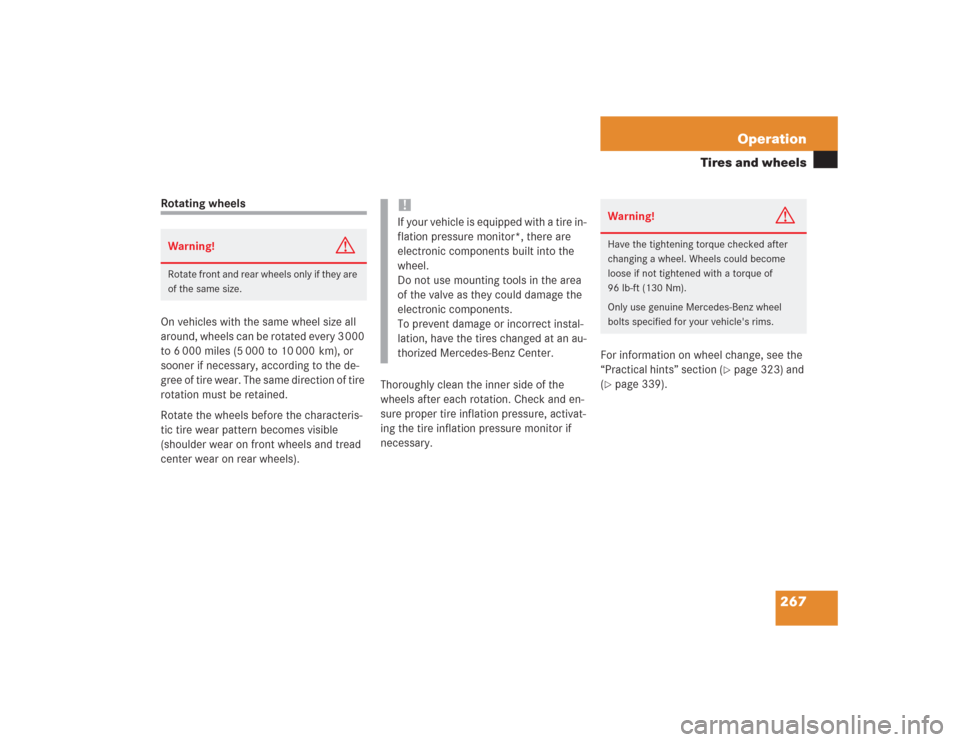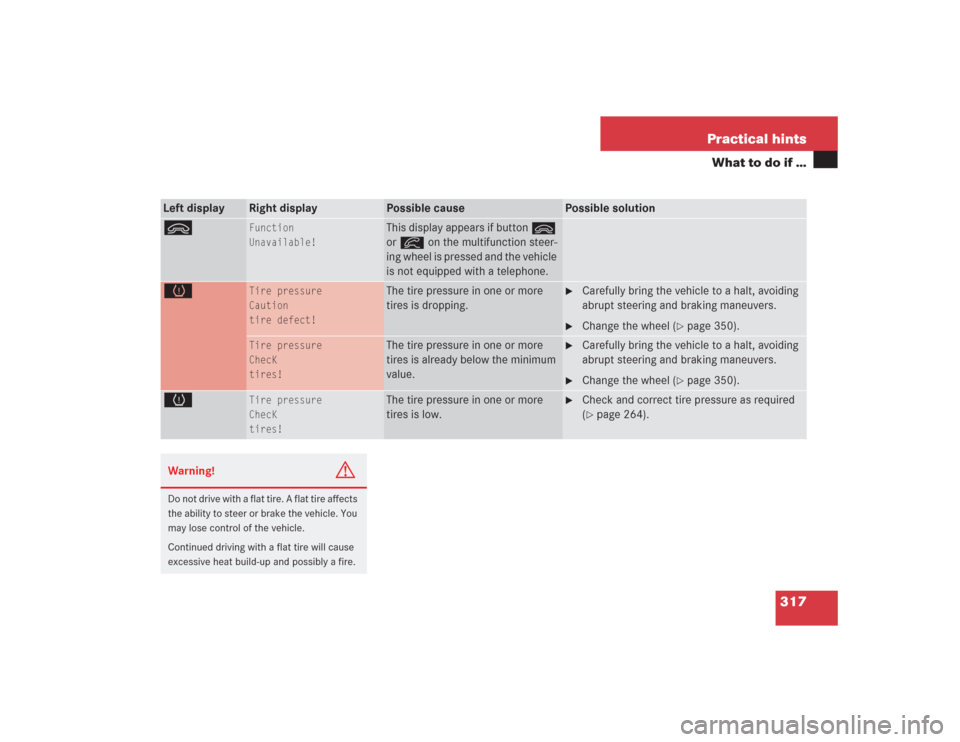Page 267 of 434

266 OperationTires and wheelsActivating the tire inflation pressure
monitor
You must activate the tire inflation pres-
sure monitor in the following cases:�
if you have changed the tire pressure
�
if you have replaced the wheels or tires
�
if you have installed new wheels or
tires
�
Make sure the tire pressure is set cor-
rectly.
�
Press the k button on the multi-
function steering wheel until the infla-
tion pressure of each tire appears in
the right display field.
�
Press the reset button (
�page 22).
The following message will appear in
the speedometer display field:
Monitor current tire pressure?
�
Press æ button.
The following message will appear in
the speedometer display field:Tire pressure displayed
after
driving a few mins.
Reactivate w/
R-button
If you wish to cancel activation:�
Press ç button.
If the following message appears in the
speedometer display field:
Reactivate tire press. monit.
�
Re-start the activation of the tire infla-
tion pressure monitor.
If the following message appears in the
speedometer display field:
Tire pressure
Check tires!
�
Re-start the activation of the tire infla-
tion pressure monitor.
iIf transporting a deflated road wheel or
additional wheel sensors in the vehicle,
the tire inflation pressure monitor
should not be reactivated until the de-
flated wheel or additional wheel sen-
sors have been removed from the
vehicle. Otherwise, the deflated wheel
or additional sensors could confuse the
tire inflation pressure monitor system
and cause it to malfunction.
Page 268 of 434

267 Operation
Tires and wheels
Rotating wheels
On vehicles with the same wheel size all
around, wheels can be rotated every 3 000
to 6 000 miles (5 000 to 10 000 km), or
sooner if necessary, according to the de-
gree of tire wear. The same direction of tire
rotation must be retained.
Rotate the wheels before the characteris-
tic tire wear pattern becomes visible
(shoulder wear on front wheels and tread
center wear on rear wheels).Thoroughly clean the inner side of the
wheels after each rotation. Check and en-
sure proper tire inflation pressure, activat-
ing the tire inflation pressure monitor if
necessary. For information on wheel change, see the
“Practical hints” section (
�page 323) and
(
�page 339).
Warning!
G
Rotate front and rear wheels only if they are
of the same size.
!If your vehicle is equipped with a tire in-
flation pressure monitor*, there are
electronic components built into the
wheel.
Do not use mounting tools in the area
of the valve as they could damage the
electronic components.
To prevent damage or incorrect instal-
lation, have the tires changed at an au-
thorized Mercedes-Benz Center.
Warning!
G
Have the tightening torque checked after
changing a wheel. Wheels could become
loose if not tightened with a torque of
96 lb-ft (130 Nm).
Only use genuine Mercedes-Benz wheel
bolts specified for your vehicle's rims.
Page 282 of 434
281 Practical hints
What to do if …
Where will I find ...?
Locking/unlocking in an emergency
Replacing bulbs
Replacing wiper blades
Flat tire
Batteries
Jump starting
Towing the vehicle
Fuses
Page 318 of 434

317 Practical hints
What to do if …
Left display
Right display
Possible cause
Possible solution
ì
Function
Unavailable!
This display appears if button ì
or í on the multifunction steer-
ing wheel is pressed and the vehicle
is not equipped with a telephone.
H
Tire pressure
Caution
tire defect!
The tire pressure in one or more
tires is dropping.
�
Carefully bring the vehicle to a halt, avoiding
abrupt steering and braking maneuvers.
�
Change the wheel (
�page 350).
Tire pressure
ChecK
tires!
The tire pressure in one or more
tires is already below the minimum
value.
�
Carefully bring the vehicle to a halt, avoiding
abrupt steering and braking maneuvers.
�
Change the wheel (
�page 350).
H
Tire pressure
ChecK
tires!
The tire pressure in one or more
tires is low.
�
Check and correct tire pressure as required
(�page 264).
Warning!
G
Do not drive with a flat tire. A flat tire affects
the ability to steer or brake the vehicle. You
may lose control of the vehicle.
Continued driving with a flat tire will cause
excessive heat build-up and possibly a fire.
Page 319 of 434
318 Practical hintsWhat to do if …Left display
Right display
Possible cause
Possible solution
H
Tire pres.
monitor
Visit
workshop!
The tire inflation pressure monitor*
is malfunctioning.
�
Have the tire inflation pressure monitor*
checked by an authorized Mercedes-Benz
Center.
�
Change the wheel.
A wheel without proper sensor was
installed.
H
Tire pressure, RL
Caution
tire defect!
The left rear tire is rapidly deflating.
�
Carefully bring the vehicle to a halt, avoiding
abrupt steering and braking maneuvers.
�
Change the wheel (
�page 350).
Tire pressure, RL
Check tires!
The left rear tire pressure is low.
�
Carefully bring the vehicle to a halt.
�
Check the tire pressure.
�
Change the wheel (
�page 350).
Warning!
G
Do not drive with a flat tire. A flat tire affects
the ability to steer or brake the vehicle. You
may lose control of the vehicle.
Continued driving with a flat tire will cause
excessive heat build-up and possibly a fire.
Page 320 of 434
319 Practical hints
What to do if …
Left display
Right display
Possible cause
Possible solution
H
Tire pressure, RR
Caution
tire defect!
The right rear tire is deflating.
�
Carefully bring the vehicle to a halt, avoiding
abrupt steering and braking maneuvers.
�
Change the wheel (
�page 350).
Tire pressure, RR
Check tires!
The right rear tire pressure is low.
�
Carefully bring the vehicle to a halt.
�
Check the tire pressure.
�
Change the wheel (
�page 350).
Tire pressure, FL
Caution
tire defect!
The left front tire is deflating.
�
Carefully bring the vehicle to a halt, avoiding
abrupt steering and braking maneuvers.
�
Change the wheel (
�page 350).
Warning!
G
Do not drive with a flat tire. A flat tire affects
the ability to steer or brake the vehicle. You
may lose control of the vehicle.
Continued driving with a flat tire will cause
excessive heat build-up and possibly a fire.
Page 321 of 434
320 Practical hintsWhat to do if …Left display
Right display
Possible cause
Possible solution
H
Tire pressure, FL
Check tires!
The left front tire pressure is low.
�
Carefully bring the vehicle to a halt.
�
Check the tire pressure.
�
Change the wheel (
�page 350).
Tire pressure, FR
Caution
tire defect!
The right front tire is deflating.
�
Carefully bring the vehicle to a halt, avoiding
abrupt steering and braking maneuvers.
�
Change the wheel (
�page 350).
Tire pressure, FR
Check tires!
The right front tire pressure is low.
�
Carefully bring the vehicle to a halt.
�
Change the wheel (
�page 350).
Warning!
G
Do not drive with a flat tire. A flat tire affects
the ability to steer or brake the vehicle. You
may lose control of the vehicle.
Continued driving with a flat tire will cause
excessive heat build-up and possibly a fire.
Page 322 of 434

321 Practical hints
What to do if …
Left display
Right display
Possible cause
Possible solution
H
Reactivate
tire press. monit
.
The tire inflation pressure monitor*
is deactivated.
�
Activate the tire inflation pressure monitor*
(�page 266).
Tire press.
monitor
currently
inactive
The tire inflation pressure monitor*
is temporarily unable to monitor the
tire pressure due to:�
the presence of several wheel
sensors in the vehicle
�
excessive wheel sensor temper-
atures
�
a nearby radio interference
source
�
unrecognized wheel sensors
mounted
�
Remove any additional wheel sensors from
the vehicle, e.g. when transporting a new set
of tires.
As soon as the causes of the malfunction have
been removed, the tire pressure monitor auto-
matically becomes active again.
Warning!
G
Do not drive with a flat tire. A flat tire affects
the ability to steer or brake the vehicle. You
may lose control of the vehicle.
Continued driving with a flat tire will cause
excessive heat build-up and possibly a fire.